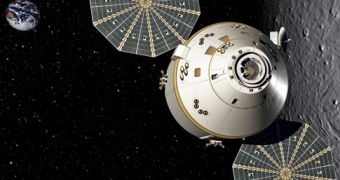Orion is a spacecraft design currently being developed by the National Aeronautics and Space Administration (NASA). Each spacecraft of this type will be able to carry a crew of four to six astronauts and will be launched by the new Ares I launch vehicle.
It is part of Project Constellation, the pride of NASA's future space plans that will send humans back to the Moon by 2020 and probably even on Mars. But before it carries the next generation of explorers into space, it will first make a shorter journey to the world's largest vacuum chamber. In this massive cathedral-like structure, it must endure a variety of rigorous challenges.
The vacuum chamber is called the Space Power Facility and it's located at NASA Glenn Research Center's Plum Brook Station in Sandusky, Ohio. The engineering marvel is 100 feet (33 m) in diameter and stands 122 feet (40 m) tall. It has the impressive ability to simulate the conditions of the vacuum of space which makes it the ideal testing grounds for the new Orion.
NASA "must demonstrate that the vehicle is capable of withstanding the harsh environment of space," said Robert Moorehead, Director of Space Flight Systems at Glenn. "The Space Power Facility will help us do that."
The Orion itself will be 75 feet (25 m) tall and will possess a new crew module for the astronauts, plus a service module to provide power, propulsion and communications. It will also have a launch abort system for emergency escapes and an adapter to connect the spacecraft to its launch system.
"The Space Power Facility will be the only facility in the U.S., if not the world, that can perform complete environmental testing on a fully assembled spacecraft," said David Stringer, director of Plum Brook Station.
"Plum Brook will have an important role to play in the future exploration of space," said NASA's Associate Deputy Administrator Charles Scales. "It's hard to believe that in less than two decades, people will look up and, with nothing but a strong telescope, see the shining lights of a research center on the moon."

 14 DAY TRIAL //
14 DAY TRIAL //